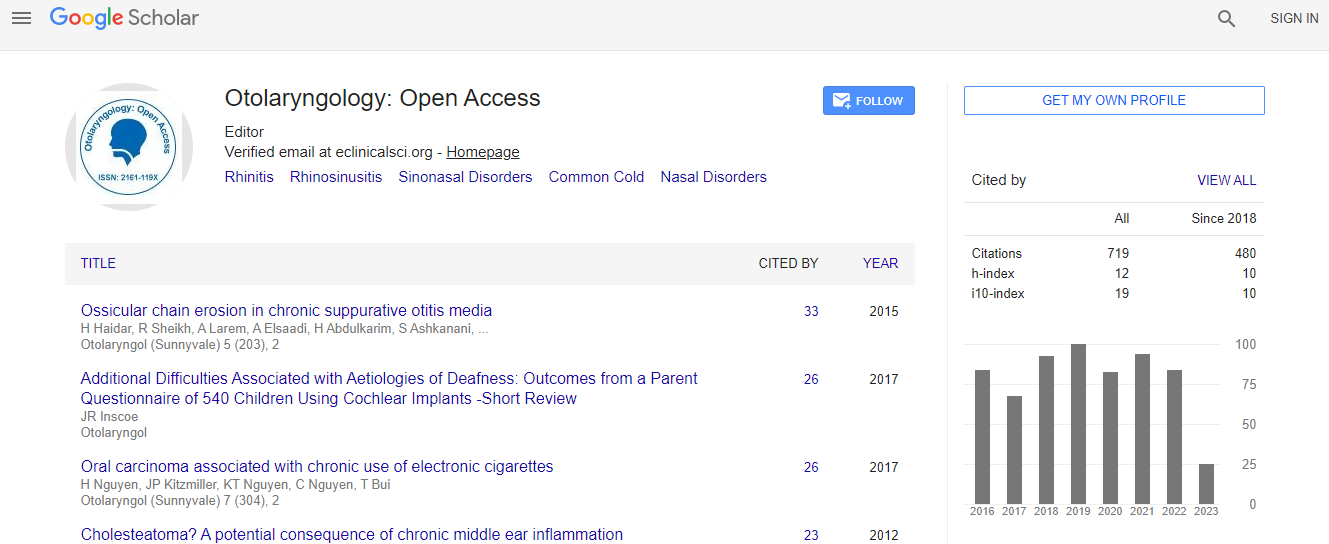Our Group organises 3000+ Global Conferenceseries Events every year across USA, Europe & Asia with support from 1000 more scientific Societies and Publishes 700+ Open Access Journals which contains over 50000 eminent personalities, reputed scientists as editorial board members.
Open Access Journals gaining more Readers and Citations
700 Journals and 15,000,000 Readers Each Journal is getting 25,000+ Readers
Google Scholar citation report
Citations : 925
Otolaryngology: Open Access received 925 citations as per Google Scholar report
Otolaryngology: Open Access peer review process verified at publons
Indexed In
- Index Copernicus
- Google Scholar
- Sherpa Romeo
- Open J Gate
- Genamics JournalSeek
- RefSeek
- Hamdard University
- EBSCO A-Z
- OCLC- WorldCat
- Publons
- Geneva Foundation for Medical Education and Research
- ICMJE
Useful Links
Recommended Journals
Related Subjects
Share This Page
The location of tympanic membrane perforation and hearing loss
International Conference on Aesthetic Medicine and ENT
Hoseok Lee
Bucheon St. Mary�s Hospital - Catholic University of Korea, South Korea
Posters & Accepted Abstracts: Otolaryngology
Abstract
Perforations of the tympanic membrane (TM) can result from trauma, middle-ear disease, or the treatment of middle-ear disease. I aim to assess the level of hearing loss in different sizes and sites of TM perforation in patients undergoing myringoplasty or tympanoplasty and to correlate the size and site of TM perforation. Records from 128 patients who had undergone tympanoplasty or myringoplasty at our clinic between August 2008 and November 2012 were examined retrospectively for this study. For evaluating the TM, the site of the perforation was classified as the following divisions: 3 quadrants (Anterior, Posterior and Central). Audiometric evaluation was performed using a clinical audiometer calibrated according to ISO standard. Hearing level was measured as the mean air conduction and mean air-bone gap (ABG) threshold at 500, 1000, 2000, and 3000 Hz and, we also categorized the frequencies as low frequency (250, 500, 1000) and high frequency (2000, 3000, 4000, 6000) to analyze the hearing in detail. We categorized the location of TM perforation simply as anterior 56 (43.8%), posterior 42 (32.8%) and central 30 (23.4%) based on the relation of the center of the perforation with the line extending from the malleus handle. According to the mean ABG among the groups, ANOVA analysis revealed that, they have significant difference (p=0.008). Categories of the hearing loss was classified as low frequency (250, 500, 1000 Hz) and high frequency (2000, 3000, 4000, 6000 Hz). We found that the posterior perforation in TM showed increasing air conduction and ABG at low frequency hearing level (p=0.023, p=0.072).Biography
Hoseok Lee completed MD from Bucheon St. Mary’s Hospital, Catholic University College of Medicine. He is working in Otolaryngology and Head and Neck Sugery department as an Otology Clinical Fellow.
Email: idea0527@gmail.com

 Spanish
Spanish  Chinese
Chinese  Russian
Russian  German
German  French
French  Japanese
Japanese  Portuguese
Portuguese  Hindi
Hindi 
